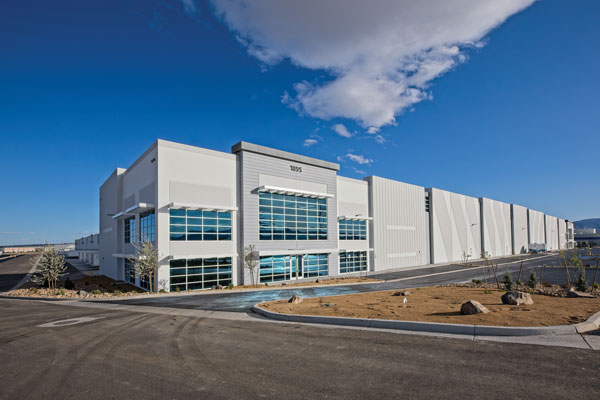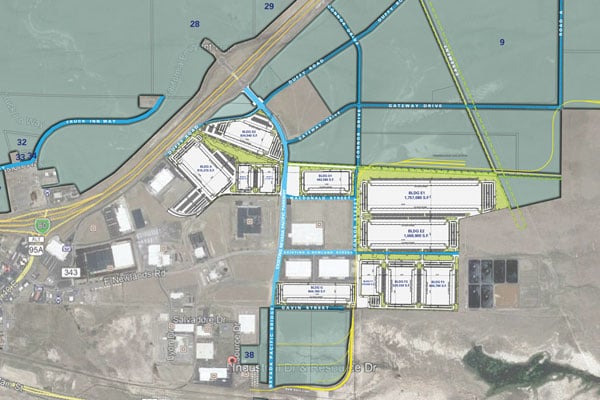
Victory Logistics District: Transforming Northern Nevada’s Desert Into a Thriving Industrial Center
Mark IV shares lessons from acquiring and master planning a 4,300-acre Opportunity Zone industrial project.
In Fernley, Nevada, approximately 30 miles east of Reno, lies Victory Logistics District, northern Nevada’s latest master-planned industrial development. The project began in July 2019 with a 4,300-acre land acquisition by Mark IV Capital, a privately held investment firm headquartered in Southern California that focuses on commercial real estate and venture capital.

Rendering of Building D-1, which will offer 500,000 square feet of Class A Industrial space for future tenants. Courtesy of Cayetano Martos
In May 2021, Mark IV launched construction on the project’s first phase of development. A year later, during the height of the COVID-induced surge in demand for distribution space, Redwood Materials leased the 815,215-square-foot building to store incoming battery components that serve as feed stock for its battery recycling operation. Mark IV then broke ground on the second phase of distribution space, which included three additional buildings totaling 1 million square feet. That phase was recently completed and is being leased by CBRE.
With almost 2 million square feet of space completed, Mark IV is now focused on the master planning and infrastructure work that will be required to bring tens of millions of additional square feet of distribution, manufacturing and data center space to the project in the coming years. With that much new development, the project is expected to generate thousands of new jobs for the area, so Mark IV is also planning a residential component with ancillary services.
Mark IV has developed, owned and operated industrial projects in Las Vegas throughout half of its 50-year history. In that time, the company has become familiar with the reasons that Nevada is considered a business-friendly state, including its low taxes and affordable energy costs. Still, Victory Logistics District has presented several challenges that have resulted in important lessons for the company as it has started to deliver this breakthrough project to the region.
Underwriting the Opportunity
While Mark IV had been strategically active in key markets in Arizona, California, Colorado, Texas and Nevada, northern Nevada was new to the firm. Getting familiar with this market was the firm’s first challenge.

Rendering of Victory Logistics District in Fernley, Nevada. Courtesy of Cayetano Martos
Sonterra Development Company had acquired the land in the mid-1990s and, over the years, developed several successful buildings that were sold to users, as well as infrastructure projects that included a freeway interchange. In the 2010s, ownership decided to move on to other pursuits, and the land became available. As soon as Mark IV became aware of the opportunity to buy the land, the company quietly began directing resources toward comprehensive due diligence, which involved conferring with economic development officials, local brokers, contractors, consultants and utilities within the region to evaluate the feasibility of a 4,300-acre industrial development project. Once under contract, Mark IV built a team of internal employees, third-party consultants and attorneys to wade through the extensive due diligence materials that existed on the 35 parcels that made up the acquisition. The team focused on the acquisition for seven months, identifying and qualifying risks and seeking solutions to mitigate as many of them as possible.
Mark IV also built relationships with relevant economic development agencies, including the Economic Development Authority of Western Nevada and Northern Nevada Development Authority, both of which helped to get the firm comfortable with committing to such a sizable undertaking. They have since helped direct potential tenants toward Victory Logistics District. The firm considers these agencies to be key resources in the early stages of land acquisition and ongoing allies in the project’s continued success.
Taking on Serious Acreage
In the past 20 years, global brands have established regional operations throughout the Reno-Sparks metropolitan statistical area (MSA), but the availability of land suitable for large-scale developments is scarce. Because of the growing demand for distribution, manufacturing and data center facilities, industrial land has been increasingly difficult to find in this area.

Victory Logistics District’s first completed building, offering 815,215 square feet of space. Courtesy of Premier Design + Build
One of the reasons is that the federal government owns about 85% of Nevada’s roughly 110,000 square miles, making that land essentially unavailable for private development. Furthermore, the federally owned land parcels aren’t generally adjacent to one another. Rather, they are in what is known as a “checkerboard” layout, making it difficult for investors or developers to assemble substantial amounts of adjoining parcels to establish large industrial hubs. The Mark IV team understood that 4,300 acres of contiguous land, well suited for large-scale industrial development, was rare in Nevada and could strategically serve the region’s needs.
Such a considerable project represented a major pivot for the 50-year-old firm, which hadn’t typically engaged in large land buys. But Mark IV, which acquires, invests in, develops and manages commercial projects in markets with strong economic fundamentals and growth indicators, knew that northern Nevada’s population was growing quickly and that its industrial sector was starting to show signs of rapid expansion. The firm also understood that given the challenges of assembling larger tracts of contiguous parcels in Nevada, this acquisition was a once-in-a-generation opportunity.
The company had previously undertaken development projects on a smaller scale. However, the leadership team at Mark IV had conducted thorough due diligence and decided to trust their instincts and invest in a long-term development strategy. They believed that focusing on high-quality design for both infrastructure and vertical development would result in a project that creates value over several decades.
Attracting the Workforce
In purchasing the land and master planning Victory Logistics District, Mark IV recognized that the project involved more than simply constructing industrial buildings. The firm also needed to fully understand the labor market and ensure that future tenants would have access to a skilled and educated workforce to staff their facilities. Mark IV estimates that the project will create more than 16,000 new direct jobs.

Aerial image of Victory Logistics’ first four completed buildings: A, B, C and D-2. Courtesy of Premier Design + Build
The challenge is that the Reno-Sparks MSA population is approximately 564,000, much lower than the populations of competing regions such as Phoenix, Las Vegas and Sacramento. The development’s two closest cities, Fernley and Fallon, are primarily residential, with populations of roughly 24,000 and 10,000, respectively. Approximately 65% of Fernley’s residents commute outside of the city limits for work. Mark IV believes it can change that by providing high-quality warehouse space that allows companies to locate near the homes of the Fernley workforce.
Mark IV is also focused on supporting the local workforce by partnering with SkillUp Coalition, a nonprofit that helps workers get hired for in-demand jobs. SkillUp connects individuals with employers seeking specific skill sets and helps to facilitate training so that job seekers have the necessary skills and knowledge to qualify for open positions. For example, if a company is interested in leasing space at Victory Logistics District and needs 100 employees to service its logistics business, SkillUp, along with its educational partners such as Western Nevada College, can help identify potential employees in the local community and train them to meet that specific employer’s workforce needs.
In addition, Mark IV understands that an increase in regional workers will result in increased housing demand. Therefore, the firm is planning to develop a wide range of high-quality local housing solutions to help decrease commute times and improve the quality of life for the growing labor force living in Fernley and Fallon.
Soil Conditions: Pros and Cons
Mark IV was attracted to the land in Fernley in part because the soil conditions and topography are unlike those found in other nearby industrial developments.
The Victory land is extremely flat, which reduced the need for costly and time-consuming grading. In addition, the sandy soil has excellent compaction and percolation characteristics ideal for construction. Whereas nearby industrial sites require dynamite to blast their rocky soil, Victory Logistics District’s geology allowed Mark IV to begin development without this added time, effort and cost.

An aerial site plan for a portion of Victory Logistics District; initial planned development calls for 30 million square feet over 2,400 acres at build-out. Courtesy of HPA, Inc.
At the same time, once disturbed by development, sand is easily displaced by the wind. This means sand must be continually removed from the project’s roads. Mark IV continues to implement mitigation solutions, such as soil stabilization and wind breaks, to contend with this challenge.
Complexity in Master Planning
As a large project, Victory Logistics District must be completed in phases; however, it is also located in an Opportunity Zone. This presents plenty of interesting advantages but also introduces an additional layer of complexity. Mark IV has needed to work with numerous local, state and federal agencies on the entitlement side, including the city of Fernley, Lyon County, state and federal transportation departments, the Federal Emergency Management Agency, the Environmental Protection Agency and the Federal Railroad Administration. This is in addition to all the utility companies that serve the property.
To navigate the agencies’ unique application and approval processes, Mark IV partnered with consultants in each of these specific areas, leaning on their expertise to ensure entitlement success in the most expeditious manner possible.
The firm also quickly realized that with a project that will span decades, it must be flexible in its approach and willing to constantly adapt to changing market conditions and tenant needs. By incorporating both speculative development and build-to-suit options into the master plan, the project can meet the needs of most tenants looking for space. Likewise, a variety of lot and building sizes gives tenants options, both for their immediate needs and their future growth plans.
Furthermore, the project offers flexibility related to deal structure, as ownership is open to ground leases and joint ventures when users are opposed to a more typical lease structure.
Since acquiring the land, Mark IV has completed two phases of speculative development totaling more than 1.8 million square feet of distribution space across four buildings. The firm continues to actively expand Victory Logistics District through additional speculative phases and build-to-suit projects for distribution, manufacturing and data center uses on the south side of Interstate 80. In addition, it is planning development on the north side that will include housing to serve the thousands of new jobs the project will generate for the area. While these plans are based on today’s needs and projections for the future, Mark IV will remain flexible in its approach and adapt as the project and the region evolve.
Serving Varying Transportation Needs
The Mark IV team knew the project would serve a variety of industrial tenants, each with different transportation needs. This presented the challenge of meeting all users’ needs in an expedient manner.

Being sited near Reno means Victory Logistics District occupiers are within a one-day truck route to most of the major population centers in the Western U.S. In addition, northern Nevada is served by I-80 and U.S. 50, transcontinental east-west thoroughfares located adjacent to Victory Logistics District. The development will also benefit from the future construction of Interstate 11, which will run from Canada to Mexico. The site has dual-served rail that runs through the project, providing service by both Union Pacific and BNSF railways. This provides Victory Logistics District occupiers with another efficient method of transportation for inbound and outbound goods. Trucking service can cost up to three times as much as rail service, and having two rail providers allows the project’s tenants to take advantage of competitive pricing.
Mark IV is also planning to build on the site a private switching facility that will receive, break down, organize, store and deliver rail cars to those tenants that have direct rail service to their buildings. In addition, a transload facility will offload cargo from rail cars to trucks and vice versa. This will allow tenants using trucking as their primary transportation solution to still take advantage of the efficiencies of the rail system at the development without the commitment of direct rail service.
Providing Adequate Power
Given the manufacturing uses that Mark IV planned for Victory Logistics District, as well as the recent wave of data center activity in the area, the ability to supply adequate power to the project is paramount. The firm needed to ensure that the local power utility could deliver both distribution-level and transmission-level power promptly to meet rapidly growing tenant demand. Likewise, the availability of renewable resources such as geothermal and solar power are critical to the end users.
In performing due diligence, Mark IV confirmed that NV Energy, which powers most of the state, was willing and able to make the necessary infrastructure improvements to bring large-scale transmission- and distribution-level energy to the project. The firm worked with the energy provider to commission an energy service agreement confirming the utility’s ability to deliver the power necessary for the project’s intended use.
Financing a Qualified Opportunity Zone Project
Victory Logistics District is positioned in a Qualified Opportunity Zone (QOZ), created as part of the Tax Cuts and Jobs Act of 2017. When Mark IV was evaluating this purchase, the program was still relatively new and just starting to generate meaningful investment. The firm discovered that the program could provide more access to development capital because it allows investors to benefit from numerous tax benefits when capital gains are used to support development in such an area. A QOZ location can also be a differentiator when marketing Victory Logistics District to future occupiers interested in using capital gains to invest in their new facilities.
Mark IV leveraged the project’s status by raising OZ investment equity for each phase of development, including $10 million in the first, $20 million in the second and additional equity for the upcoming third phase.
The project began in the middle of uncertainty related to the COVID-19 pandemic. Despite the challenging lending environment, the firm developed a positive relationship with Comerica for construction loans.
Looking Ahead
Maintaining a long-term outlook on such a significant development can be challenging, but it also presents opportunities to be flexible in planning as the northern Nevada market evolves.
Consistent with management strategy in its other regions, the firm has situated the company’s Nevada team in a new office located in one of its buildings at Victory Logistics District. This office will also serve as a showpiece for the construction quality the firm is committed to and will host potential tenants as they tour the project.
Victory Logistics District’s build-out is anticipated to continue for many years as Mark IV carefully evolves its master plan and brings it to fruition via strategically phased construction. The firm is excited to see this project’s impact on the local economy as it meets the growing demand for high-quality distribution, manufacturing and data center space in northern Nevada.
Evan Slavik is president and CEO at Mark IV Capital.
Opportunity Zones So FarThe 2017 Tax Cuts and Jobs Act created the Opportunity Zones program, which aims to spur investment in undercapitalized communities. The program provides temporary deferral of taxes on previously earned capital gains placed in Opportunity Funds and permanent exclusion of taxable income on new gains. The analyses of the program have just begun, but according to a 2023 article by the Urban Institute:
|
Industrial and Logistics Growth in Northern NevadaDemand for industrial and logistics space in northern Nevada is rising steadily, with historically low Reno industrial vacancy rates of 4.2% and an expectation that this demand will continue. According to recent CBRE market research, average asking lease rates for bulk product increased by 10% between Q4 2022 and Q4 2023. This represents a 47% increase in asking lease rates for bulk product since the fourth quarter of 2021. Northern Nevada Business Weekly reports that the market’s strategic location between major population hubs and ports along the West Coast provides distribution and logistics companies with a competitive advantage. The strength of e-commerce and the rise of nearshoring (relocating operations closer to home) are driving this demand. In addition, increasing automation and emerging artificial intelligence are fueling data center growth. Nevada is a prime location for data centers because of its strategic location, cost effectiveness, energy reliability, connectivity and supportive policies. Furthermore, Nevada is answering the rising call for sustainability with more solar, thermal and other green energy initiatives in constructing and operating its logistics facilities. |




